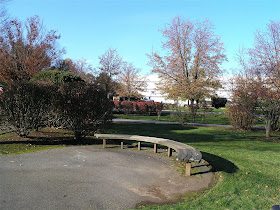Yet another spring flower, this daylily was photographed November 4 and has a cluster of buds. Crazy!

ColoradoGuy took pictures of foliage in New Jersey the day before Thanksgiving, November 21, 2007 and posted them here. Yesterday, which was Saturday, November 8, 2009, I followed his footsteps and have uploaded images of the current appearance of the same locations, immediately beneath his photos.
Horseneck Road bridge. Click on it for the full effect.
Contrast that with how it looked when I arrived.
It wasn't easy to find a leaf worth a picture, but I liked the shape of this one.
From my shadow on the bridge it's apparent how huge the tree in the
foreground is. It's terrible that it and all the others are dying.
ColoradoGuy also photographed Kyocera headquarters in Fairfield.
We haven't seen anything like these saturated reds this fall, and
the trees have lost their leaves at least a month earlier than in 2007.
Notice that at least one burning bush, in the front of this hedge,
has been removed - presumably because it died in the last couple of years
Next, our peripatetic mountaineer shot some photos of trees in glory
at a park across the street.
But when I went there, a hoard of workers were already loudly
blowing the brown leaves into piles.
And there was nothing remotely comparable to the flaming
color that was there, 3 weeks before this time of year, in 2007.
Here is the breathtaking setting for a bench back then.
But who would want to sit and contemplate the barren waste
our landscape is fast becoming now?
Since we were in the neighborhood, we stopped at the Montclair Art Museum to view an exhibit of Cezanne and his influence on American Painters. There is a room there dedicated to George Innes, who painted in Montclair in the 1800's.
What a fabulous collection. At the rate we're going, we will be left only with art, photographs, recordings and stories with which to remember the beautiful environment and animals we once had.
This magnificent dawn redwood stands in front of the museum. You can't tell from a distance, but it is fringed with long streams of tiny baby cones. Some mature samples from last year are on the ground, not even an inch across. I love the way it looks like an array of diminutive pouting human lips. Nature often imitates her creations in amusing ways, like a gigantic fractal.
Another truly amazing video can be seen here, a news conference with two young women who have started their fast.
From a primer of neat brevity explaining climate change:
"Since the industrial revolution humans dug, pumped and burnt more than 320 billion tons of carbon which accumulated as the result of biological activity during 400 million years. 320 billion tons of carbon is more than 50% the carbon concentration of the original atmosphere (540 billion tons). As a consequence the level of CO2 in the atmosphere has risen by about 40%, from 280 to 388 ppm."














Interesting but not very scientific. Were these pictures taken with the same make of camera?
ReplyDeleteClimate changes would not be showing up in just a couple years. Every winter is a bit different most places.
Thank you for your comment Don Thieme. I can't claim to be a scientist, unfortunately!
ReplyDeleteThe pictures were taken by different people and different cameras. The point is they were taken at the exact same place in different years, and clearly demonstrate that this year, the leaves fell off at least a month earlier than they did in the earlier photos. That's just a fact.
And I agree, climate change isn't sufficient to my mind to explain why the trees have all exhibited signs of irreversible decline over such a short period of time, although there are such things as tipping points, where a slower less noticeable change suddenly accelerates.
However since this past summer when not just the trees planted in the ground, but those in nurseries, and potted as well as aquatic plants also exhibited symptoms of atmospheric toxicity, there is enough evidence to strongly suggest that the "other" greenhouse gases, ozone and nitrous oxide and carbonyls and such, are more directly responsible for foliar damage than the warming and drying from CO2 induced climate change.
I wish nothing more than some qualified researcher establish a link between the composition of the atmosphere, fuel emissions, and the empirical observation of dying vegetation. And soon, before everything goes extinct!